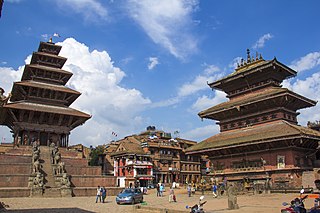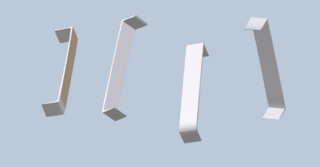Related Research Articles

The Battle of Adwa was the climactic battle of the First Italo-Ethiopian War. The Ethiopian forces defeated the Italian invading force on Sunday 1 March 1896, near the town of Adwa. The decisive victory thwarted the campaign of the Kingdom of Italy to expand its colonial empire in the Horn of Africa. By the end of the 19th century, European powers had carved up almost all of Africa after the Berlin Conference; only Ethiopia and Liberia still maintained their independence. Adwa became a pre-eminent symbol of pan-Africanism and secured Ethiopian sovereignty until the Second Italo-Ethiopian War forty years later.

Dragoons were originally a class of mounted infantry, who used horses for mobility, but dismounted to fight on foot. From the early 17th century onward, dragoons were increasingly also employed as conventional cavalry and trained for combat with swords and firearms from horseback. While their use goes back to the late 16th century, dragoon regiments were established in most European armies during the 17th and early 18th centuries; they provided greater mobility than regular infantry but were far less expensive than cavalry.

The history of Nepal is intertwined with the history of the broader Indian subcontinent and the surrounding regions, comprising the areas of South Asia and East Asia.

Bhaktapur, known locally as Khwopa and historically called Bhatgaon, is a city in the east corner of the Kathmandu Valley in Nepal located about 13 kilometres (8.1 mi) from the capital city, Kathmandu. Bhaktapur is the smallest city of Nepal as well the most densely populated. Along with Kathmandu and Lalitpur, Bhaktapur is one of the three main cities of the Kathmandu Valley and is a major Newar settlement of the country. The city is also known for its Newar tradition, cuisine and artisans. Bhaktapur suffered heavy damage in the April 2015 earthquake.

The Battle of Didgori was fought between the armies of the Kingdom of Georgia and the Seljuk Empire at the narrow place of Didgori, 40 km west of Tbilisi, on August 12, 1121. The large Muslim army, under the command of Ilghazi, was unable to maneuver and suffered a devastating defeat due to King David IV of Georgia's effective military tactics.

Doti, also known as Doti region, Dotigarh (डोटीगढ़) as used in the Jagar, in the Farwestern region of Nepal, is a region situated between River Kali bordering Kumaon division of Uttarakhand in the west and the Karnali river on the east. Doti was one of eight different princely states of the Katyuri Kingdom.

The Malla dynasty was the ruling dynasty of the Kathmandu Valley in Nepal from 1201 to 1779. They were a Raghuvanshi dynasty who were seen as the descendants of the Licchavi dynasty. Later Malla kings also traced one section of their lineage from Nanyadeva, the founder of the Karnat dynasty of Mithila. The term malla means wrestler in Sanskrit. The first use of the word malla in the Kathmandu Valley begins from 1201. The Malla period was a golden one that stretched over 600 years, as they presided over and flourished the Newar civilization of Nepal Mandala which developed as one of the most sophisticated urban civilisation in the Himalayan foothills and a key destination in the India-Tibet trade route.

The Welayta, Wolayta or Wolaitta are an ethnic group and its former kingdom, located in southern Ethiopia. According to the most recent estimate (2017), the people of Wolayta numbered 5.83 million in Welayta Zone. The language of the Wolayta people, similarly called Wolaytta, belongs to the Omotic branch of the Afro-Asiatic language family. Despite their small population, Wolayta people have widely influenced national music, dance and cuisine in Ethiopia.

Nissanka Malla, also known as Keerti Nissanka and Kalinga Lokesvara was a king of Polonnaruwa who ruled the country from 1187 to 1196. He is known for his architectural constructions such as the Nissanka Lata Mandapaya, Hatadage and Rankot Vihara, as well as for the refurbishment of old temples and irrigation tanks.

History of Bankura district refers to the history of the present Bankura district in the Indian state of West Bengal.

Wolayita or Wolaita is an administrative zone in Ethiopia. It is named for the Welayta people, whose homeland is in the zone. Wolayita is bordered on the south by Gamo Gofa, on the west by the Omo River which separates it from Dawro, on the northwest by Kembata Tembaro, on the north by Hadiya, on the northeast by the Oromia Region, on the east by the Bilate River which separates it from Sidama Region, and on the south east by the Lake Abaya which separates it from Oromia Region. The administrative centre of Wolayita is Sodo. Other major towns are Areka, Boditi, Tebela, Bele, Gesuba, Gununo, Bedessa and Dimtu.
Goffa or Gofa are an Omotic ethnic group indigenous to Omo Valley located in Ethiopia's Southern Nations, Nationalities, and Peoples' Region. According to 2007 census there are 363,009 ethnic Goffa in Ethiopia, which make up around 0.49% of the country's total population. Traditional language of the Goffa is the Goffa language, which belongs to the Omotic branch of the Afroasiatic languages.
Khasa-Malla kingdom, popularly known as Khasa Kingdom and Yatse in Tibetan, was a medieval kingdom from the modern day far-western Nepal and parts of Uttarakhand state in India, established around the 11th century. It was ruled by kings of Khasa tribe who bore the family name "Malla". The Khasa Malla kings ruled western parts of Nepal during 11th–14th century. The 954 AD Khajuraho Inscription of Dhaṇga states Khasa Kingdom equivalent to Gauda of Bengal and Gurjara-Pratihara dynasty.

Jhargram Raj was a zamindari which occupied a position in Bengal region of British India. The zamindari came into being during the later part of the 16th century when Man Singh of Amer was the Dewan/Subahdar of Bengal (1594–1606). Their territory was centered around present-day Jhargram district. Jhargram was never an independent territory since the chiefs of the family held it basically as the zamindars of the British Raj in India after Lord Cornwallis's Permanent Settlement of 1793. Although its owners were both rich and powerful, with the chiefs of the family holding the title of Raja, the Jhargram estate was not defined as a Princely State with freedom to decide its future course of action at the time of Indian independence in 1947. Later, the Vice-Roy of India agreed to recognize Jhargram as "Princely State" after the Second World War, but the proposal taken back as the British had decided to give independence to India.

Kingdom of Wolaita, also known as Wolaita Kingdom, was a kingdom dominated by Wolayta people in today's southern Ethiopia from 1251 until conquest of Ethiopian Empire in 1894.

Kawo Tona Gaga was the last and most powerful king of the Kingdom of Wolaita. Tona Gaga was the 17th Kawo, or king, of the Tigre dynasty, the last independent dynasty of the Wolayta people. Upon succeeding his grandfather in 1890 he quickly built ties with the Kingdom of Jimma, a tributary of the Ethiopian Empire, marrying the daughter of Abba Jifar II. However, he refused to pay tribute to Shewa He then tried to draw the smaller Omotic Kullo and Konta into his orbit as client states, however, Menelik's cousin Wolde Gyorgis successfully campaigned through both. After six times failed protectorate attempt, Emperor Menelik II reached the border of Wolaita after a two weeks march from Addis Abeba, calling on the king to pay tribute and avoid the destruction of his kingdom. Tona prepared his fortifications and refused negotiation. Expertly dug defensive trenches and mounds crippled the initial assault, but Tona Gaga was eventually pushed out of his strongpoint and caught between the Ethiopians and Oromo auxiliaries sent by Abba Jifar II, who had betrayed Tona Gaga. After his capture in 1894, the ex-king was baptized as Tekle Haymanot and made the governor of his previous dominion. He would later assist Menelik II in multiple campaigns.
Ogato Sana, also known as Kawo Sana Ogato in the Wolaitta language, was the one of the most renowned kings of the Tigre dynasty along with the Kingdom of Wolaita. King Ogato had acquired all of the regions, not only by battle, but also through deception and the employment of spys among the Gamo, Gofa, Kucha, and Kambata tribes. During his reign, the pre-colonial Wolaita kingdom's agricultural modernization effort included expanding acreage, installing irrigation canals, and improving cattle breeds in order to implement modern dairy farming. King Ogato Sana was 10th rulers of the Wolaita kingdom under the Tigre dynasty. King Ogato had erected his palace at top of the Damot hills, driven the Hadiya people out of the present-day Humbo and Abaya in the north, and captured other provinces. To protect himself from intruders, he erected a fortification around his castle on Damot hill, as well as a defense trench surrounding Sore Mashedo.
Dalbo is a town in Southern Nations, Nationalities, and Peoples' Region, Ethiopia within Wolayita Zone. Dalbo is located about 304 km away from Addis Ababa to the south through Butajira. And the town is located 11 km, North from Sodo, the capital of Wolayita Zone. The coordinate point of the town in map is 6°54′0″N 37°52′0″E with elevation of 2349 meters above the sea level.
Sana Tube, or Tube Sana in the Wolaitta language, was the one of the kings of the Kingdom of Wolaita. He was from the Tigre dynasty. Kawo Sana was the 9th king from the Wolaita Tigre dynasty. During his reign, the pre-colonial Kingdom of Wolaita had fought with the nearby rival peoples and states of Hadiya, Arsi, Gujii, Sidama and Kembata, after he stabilized the kingdom and extended the frontiers to the present areas of Offa, Humbo, Boloso Sore and Damota. The king was highly concerned about the annexation of Wolaita territories by strangers and determined to fight against warriors. He annexed Kulo and Dawuro.
References
- ↑ "king motolomi of wolaita kingdom". www.academia.edu.
- 1 2 "legacy of wolaita during motolomi" (PDF). www.globalscientificjournal.com.
- ↑ "Wolaita People's History, Culture, and Religon[sic]". allaboutethio.com.